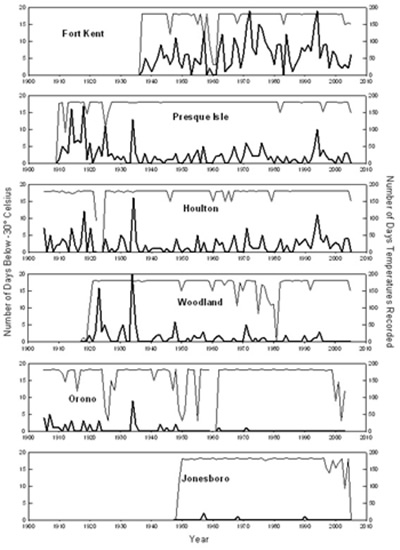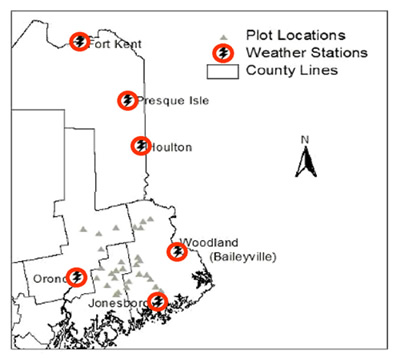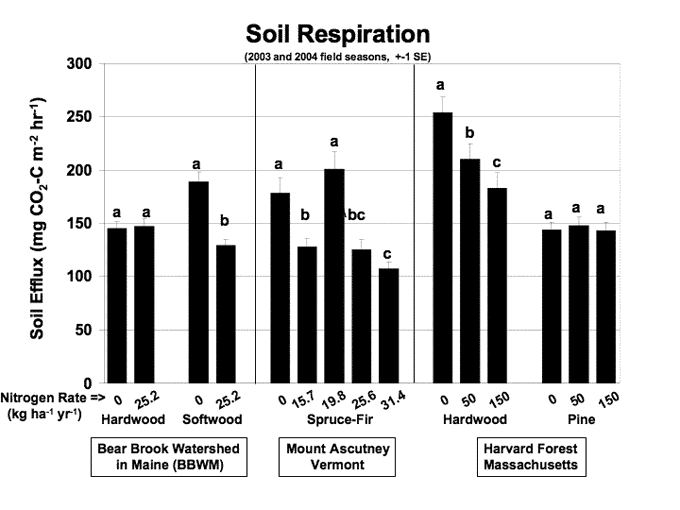Maine’s forests have always been influenced by a changing climate and the future will be no different. If the past is any indication, projected global warming over the coming century will likely alter the growth and species composition of Maine’s forest. Predicting the nature of these changes, however, is a challenging task.
If patterns of precipitation are not reduced significantly, warmer temperatures and increased atmospheric CO2 will likely improve forest growth in the region. The largest potential influence and the one most difficult to predict is how climate change will alter the composition of tree species. Because Maine’s forests are in a transition zone between the eastern temperate forest to the south and boreal forest to the north, any climate induced changes to our forest are likely to occur quicker and be more pronounced here than in other places. In a warming climate it seems reasonable to expect that tree species currently at the northern edge of their distribution (e.g., eastern white pine, red maple, and sugar maple) will likely be favored over those species that are now at the southern end of their distribution (e.g., balsam fir, trembling aspen, and white birch).
Since most all of the half million acres harvested annually in Maine is naturally regenerated, the effects of climate change on forest composition will occur largely during the early stages of forest development. Climatic influences on the germination of tree seeds and on seedling establishment are likely to be the primary determinants of future forest composition. Recent research by the University of Maine suggests that interactions with rodents and climatic conditions when seeds are dispersed are likely to be important factors determining the species of seeds that successfully germinate and survive. Thus, the effects of climate change on seed-eating animals and pathogens are likely to create complex interactions that will determine which tree species dominate under specific circumstances.
Further complications to predicting how the forest will change include understanding the effects of a new climate on patterns of natural disturbance (e.g., fire and hurricanes), the spread of introduced and native insect pests (e.g., balsam woolly adelgid and spruce budworm), and the spread of invasive exotic plants (e.g., Norway maple).
Human influences also will be important in determining the character and impact of the changing forest. For example, the widespread use of partial harvesting over the past decade has created unprecedented forest conditions that will change seed sources and microclimatic conditions for seedling establishment. The long-term effect of these harvesting practices is not understood in our current climate, let alone under an altered climate. Silviculture (tree planting, thinning, etc.) also can be designed to mitigate some negative effects of climate change, but how and what will be required, if anything, is still a matter of debate. Projected increases in suburban and urban sprawl into currently undeveloped forestlands across the state also will have an impact. Significant increases in the number of people and communities at the suburban/forest interface will increase the sensitivity of Maine citizens to changing forests, as well as creating additional stresses to forests that are reacting to climate change.
Predicting how these myriad factors will interact with climate change during the coming decades is among the biggest research challenges facing forest researchers.
Climate change will impact tree health due to two major processes: i) Climate extremes will physiologically damage tree tissues resulting in diebacks and declines, and ii) warmer winter temperatures will increase the survival of tree pests.
It seems contradictory, but Maine’s current climate of abundant moisture throughout the year predisposes the trees to drought damage. This occurs when trees can regenerate on sites that have enough moisture in normal years but inadequate moisture during drought extremes. Such a situation occurred with brown ash (=black ash, Fraxinus nigra) when a "100 yr" drought in May 1985 and 1987 resulted in severe dieback in trees growing on sites where high water tables resulted in shallow rooting. Another, more severe decline occurred in white pine (Pinus strobes) in southern Maine when a "100 yr" drought in this region in 1995 incited a die-off of up to 60% of trees in stands where roots were kept shallow due to soil barriers.

widespreaddieback of American beech (Fagus grandifolia) in northern Maine where
warmer wintetemperatures could be allowing another invasive insect, the beech
scale (Cryptococcusfagisuga), to reach damaging levels. In both cases, severe
droughts in2001 added additional stressesthat likely resulted in much higher
mortality. This scenario of warmer winter temperaturesand drought stress will
likely aid the invasion of Maine by anotherinvasive tree pest,the hemlock
woolly adelgid(Adelges tsugae).
Impact of exotic, invasive pests have been limited in Maine due to cold winter temperatures causing high mortality of over wintering stages. However, a recent study linked warmer winters since 1940 with increasing damage and mortality of balsam fir (Abies balsamea) due to the balsam woolly adelgid (Adelges piceae)
Climate change will be a major factor in determining future diebacks and declines of trees in the state.

enough to kill virtually all adelgids on balsam fir. Temperaturerecords
from NWS stations as shown above
Research in forest soils and watershed biogeochemistry cuts across multiple disciplines to study the influence of the chemical (e.g., acid deposition) and physical (e.g., temperature and moisture) climate on forest ecosystem function at plot, watershed, and landscape scales. A particular emphasis is the role of soil and belowground processes on whole ecosystem function. Several long-term research projects (i.e., multi-decadal) study the effects of atmospheric nitrogen and sulfur deposition on forest ecosystems and the interactions of these processes with both short-term and long-term climatic phenomena. Particularly relevant to climate is our research on carbon sequestration, nitrogen saturation, soil warming, base cation depletion, metal mobilization, and phosphorus cycling as influenced by atmospheric chemistry, temperature and moisture.
The figure below shows preliminary data from our research evaluating the influence of atmospheric nitrogen deposition on soil CO2 efflux (known as soil respiration) in forests. The data are an example of the linkage between atmospheric chemistry (nitrogen deposition), ecosystem processes (soil respiration due to microbes and roots) and the global climate system (driven by terrestrial CO2 sources and sinks such as the process studied here).

